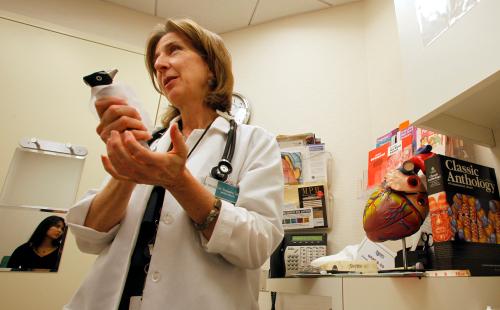The national debate over health insurance coverage brings a realization of how high healthcare costs have climbed nationally. The U.S. spends a higher share of GDP on healthcare (17.9 percent) than any other country, but its health outcomes consistently underperform those same countries. Some of this inefficiency stems from redundant medical services: the Congressional Budget Office estimates the cost of procedures that did not improve health outcomes at $700 billion per year. To increase the efficiency of American healthcare, policymakers look to technologies like health information exchanges (HIEs) that detail the results of tests and treatments a patient has already received. In a new paper, CTI fellow Niam Yaraghi, along with coauthors from SUNY Buffalo and the University of Connecticut, analyze the adoption of HIEs in western New York to determine their effect on lowering the repetition of medical procedures.
According to the research, the adoption of health information exchanges can improve healthcare quality while also lowering costs. A patient might see physicians and specialists at multiple locations over the course of treatment, but without a reliable mechanism for sharing information between them, tests are liable to be repeated. Armed with instant access to a patient’s current medical history, doctors can better decide which new tests and treatments are medically necessary, even when urgent conditions allow little time for deliberation. Avoiding unnecessary medical procedures saves valuable time and lowers a patient’s exposure to risks associated with certain treatments. Health information technology promises to improve the experience for patients while lowering costs for insurers and taxpayers.
To judge the impact of health information exchanges, Yaraghi and his coauthors obtained data from the Center for Medicare and Medicaid Services on medical services received by Medicare patients, and compared that data to information on the adoption of HIEs from HEALTHeLINK, the regional network for western New York. The study identified 332 medical procedures that are performed at both HIE member and non-member locations. The results show that an HIE lowers the repetition of therapeutic procedures, those aimed at improving a patient’s condition, but HIE adoption did not affect diagnostic procedures that determine the extent of a patient’s illness.
In this study, the main variable of interest is the ratio of repeated tests to the unique patients that a physician sees. For example, a physician that performs a specific therapeutic medical procedure 100 times for 73 unique patients repeats the procedure 27 times, an average ratio of repetition of 0.27. Assuming other variables are fixed at their average level, the results show that the average ratio of repetition for that physician will fall to 0.26 after one year of experience in the HIE system. This means that the physician would perform that test 98 times for the same 73 patients, avoiding 2 repetitions. The study’s authors estimate that had all the physicians in the United States been using HIE, Medicare would have saved $63 million annually for each therapeutic procedure performed at physicians’ offices.
Future study could examine how doctors incorporate HIEs in their practice to identify new ways that the technology can lower healthcare costs.
Read the full paper“Do Health Information Exchanges Deter Repetition of Medical Services?” here.
The Brookings Institution is committed to quality, independence, and impact.
We are supported by a diverse array of funders. In line with our values and policies, each Brookings publication represents the sole views of its author(s).








Commentary
Health information exchanges reduce redundant medical procedures
May 26, 2017